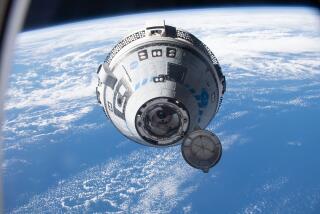Decoding Columbia: A detective story
James Hallock discovered just how little it takes to bring down a space shuttle.
He did it by playing with pencils.
As a member of the Columbia Accident Investigation Board, the pear-shaped, bewhiskered expert on flight safety had a New Englanderâs flinty skepticism and a physicistâs distaste for untested accident theories.
On this day, Hallock, 62, scowled at specifications for the reinforced carbon panels that shielded the leading edge of Columbiaâs wings from the heat of reentry.
If one of the $800,000 panels had cracked, it might have been the flaw that on Feb. 1 caused the $1.8-billion spacecraft and its crew of seven astronauts to plummet in a shower of molten debris across six states.
Hallock brooded over a simple question: What would it take to break one?
Engineers gave him the original 25-year-old NASA specifications, which said the panels must withstand an impact equal to the kinetic energy of 0.006 foot-pounds. What did that mean? Hallock twiddled a yellow No. 2 pencil between his fingers. How far, for instance, would he have to drop the pencil to generate that kind of impact?
In the mailroom at the boardâs makeshift headquarters in Shirlington, Va., he found a box of pencils and a postal scale.
He weighed the pencils, then calculated the mass of the average pencil. With that number, he worked out how much punch each pencil would pack.
âThe answer,â he would say later, âis that a No. 2 pencil dropped from about 6 inches equals the kinetic energy number they had.â
The panels, in actual manufacture, were much stronger. But that remarkably low standard, Hallock believed, was a tangible measure of how confident NASA engineers were that nothing would hit the leading edge of the wing.
âThe number didnât matter to them,â Hallock said, âbecause they assumed nothing would ever hit the shuttle.â
Call it forensic engineering or, more plainly, detective work.
The Columbia accident investigation was the most exhaustive scientific inquest ever undertaken.
Suspicion led down a hundred blind alleys. Investigators quarreled. Mission insiders tried to control the probe. Outsiders railed about secrecy.
The investigators mustered the most sophisticated techniques that science could devise â X-ray scanners, neutron beam machines, hypersonic wind tunnels.
They also used red food coloring, a bicycle pump, a hobby-shop hacksaw and a steam iron.
They conducted some tests in classified military laboratories, others in the nearest kitchen sink.
In arcane debates about trapped-gas analysis, radar cross sections and spatter metallurgy, they stalked answers to wrenching questions of guilt, shame and responsibility.
Doug Stevens / LAT Leroy Cainâs shuttle was lost, and now everyone in the room would be caught up in the investigation. |
Every imperfection they found revealed a human face.
All that they discovered reinforced what Hallock learned by dropping his No. 2 pencil.
The space shuttles are by design unsafe.
As the most complex flying machines ever assembled, each shuttle contained more than 2.5 million parts, 230 miles of wiring, 1,060 valves and 1,440 circuit breakers. All of it had to function properly at extremes of speed, heat, cold, gravity and vacuum â the interaction of its parts just at the edge of human understanding and control.
From liftoff to landing, the shuttles flew in peril.
In orbit, they maneuvered through a hailstorm of 10,000 man-made objects larger than a softball and millions of smaller pieces of debris. At orbital velocities, an object no larger than a pea carried the force of a falling 400-pound safe.
During NASAâs first 75 shuttle flights, technicians had to replace 60 cockpit windshields â at $40,000 each â because of pitting from debris.
But launch was even more dangerous. Orbiting junk at least could be tracked by radar and avoided.
For all their efforts, shuttle engineers could not stop ice and chunks of insulating foam from falling off the shuttleâs 15-story external fuel tank and striking the spacecraft during its eight-minute ascent into orbit.
Agency engineers could not fix this fundamental flaw, nor could they craft a safer vehicle. They dared not abandon the only vehicle the country had to carry people into space.
So NASA continued to launch the shuttles, gaining confidence each time the crew returned safely.
âThe program had been put in this box they could not get out of,â said Scott Hubbard, director of NASAâs Ames Research Center in Mountain View, Calif., and a member of the investigating board.
Blind to the consequences, they had constructed a trap and baited it with ambition.
In the winter darkness, Caltech astronomer Tony Beasley, 38, shivered in his front yard.
According to the announced flight path, Columbia would soon swoop over moonlit mountain slopes draped with snow and above the white, upturned antenna dishes of the universityâs Owens Valley Radio Observatory.
His wife and mother-in-law, wrapped in a rug to ward off the February chill, stood beside him. Stifling yawns, cupping hot mugs of tea, they scanned the star fields over Bishop for the returning shuttle.
Beasley rarely paid attention to anything so close to Earth. He managed Caltechâs millimeter astronomy array and, in his spare time, studied the motion of galaxies through the deep cosmos.
Two local photographers, however, had convinced him that the sight of the shuttleâs predawn reentry over Northern California would be especially memorable.
Just before 6 a.m., Columbia slashed the dark from horizon to horizon. Staccato flashes punctuated its passage.
The fiery pink streak left the afterglow of a holiday sparkler. It burned in Beasleyâs eyes long after the shuttle itself, traveling at 4 miles per second 40 miles overhead, vanished in the eastern haze.
The burly Australian astronomer could not make sense of the bright pulses of light that trailed in Columbiaâs wake.
His mother-in-law was puzzled too.
They might be tiles, Beasley told her. I think the shuttle normally sheds some tiles on reentry, he said. He didnât give it a second thought.
The stargazer ducked into the warm kitchen, ate a piece of toast with peanut butter, then drove to the observatory.
He had no inkling how obsessed he would become with the streak of light he had just witnessed.
One Columbia crew member didnât wear a space helmet, so smooth was the descent.
Too elated to bother, or perhaps too confident, three of them did not put on their orange pressure-suit gloves.
On the flight deck, shuttle commander Rick Husband, 45, chugged down three plastic flagons of saline solution to keep from getting lightheaded, a common side effect of reentry. It tasted slightly like seawater.
Pilot William McCool, 41, pored over a pre-landing checklist. Crew members Kalpana Chawla, 41, and Laurel Clark, 41, sitting behind him, watched raptly as superheated gases licked across the cabin windows.
Seated back in the mid-deck area, Michael Anderson, 43, David Brown, 46, and Ilan Ramon, 48, could not see what lay ahead.
The seven men and women were plunging out of orbit into the atmosphere over the South Pacific on the last leg of a journey that 22 years of repetition had turned into a NASA routine.
For 16 days, they had circled Earth. Now they could return.
The shock of Columbiaâs passage was ripping apart molecules of the thickening air. Atoms blazed furiously. Faster than a bullet, the shuttle hurtled down a tunnel of excited particles, glowing within a glow, like a firefly trapped inside a fiery neon tube.
âIt looks like a blast furnace,â Husband told his crew in cabin talk captured on Clarkâs video camera.
Gravity gently took hold inside the spacecraft. A notecard floated to the floor. At 24 times the speed of sound and 250,000 feet over Hawaii, the shuttle encountered temperatures of 3,000 degrees Fahrenheit, and the light danced even harder outside.
âItâs really getting bright,â McCool exclaimed.
Seething plumes of ionized gas â orange and yellow, reddish purple and pink â swirled around the capsule.
âYou definitely do not want to be outside now,â Husband replied.
They chuckled. Columbia automatically began banking to the right. The Earth below swung into view. Home.
In Houston, lead flight director Leroy Cain watched a glowing line track Columbiaâs reentry across a world map covering one wall in the windowless auditorium of Mission Control. This was his 12th mission.
Abruptly, instrument readings from four temperature sensors aboard Columbia flickered off.
No one in the five rows of systems engineers in front of Cain could tell him why.
To all appearances, the spacecraft was flying normally northeast of Yosemite, heading toward a routine landing in Florida.
Cain double-checked. âEverything look good to you?â he asked the engineer monitoring guidance and control.
âI donât see anything out of the ordinary,â came the reply. The Johnson Space Center tape recorders and video cameras preserved every word.
Five minutes later, pressure readings from two of Columbiaâs tires ceased. The shuttle flew on, approaching Dallas and Fort Worth, slowing to 21 times the speed of sound.
Cainâs thoughts raced down a dozen avenues of contingency and response, as he had practiced in so many mission simulations. Each was a dead end.
Ninety seconds passed.
âColumbia, [this is] Houston,â radioed Marine Lt. Col. Charles Hobaugh, 42, the astronaut in charge of Mission Controlâs communications with the shuttle crew. âWe see your tire pressure messages, and we did not copy your last call.â
Aboard Columbia, shuttle commander Husband keyed the microphone switch. âRoger,â he replied. âUh, buh .... â
His transmission ended mid-word.
With all its electronic senses, NASA strained for a telling signal. Frantically, engineers paged deeper into thick manuals of procedures. They sought to restore communication.
âColumbia? Houston. UHF comm check,â Hobaugh radioed, trying to raise the crew.
No response.
âColumbia? Houston. UHF comm check,â he repeated.
Silence.
âColumbia? Houston. UHF comm check.â
The minutes dragged. Mission Control, cut off from any sensation of the world beyond its unresponsive computer monitors, was paralyzed as if by a stroke.
Sixteen minutes after the first sensors faltered, a cellphone rang. Someone watching television at home had called a NASA official in the control room, who in turn murmured the news to the flight director.
Columbia had burst into a confetti of debris.
Torn into thousands of pieces, it was falling with a rolling rumble of sonic booms across Texas and Louisiana. From the ground, the disintegrating spacecraft was a winter thunderstorm of wreckage.
Quietly, Cain worked his jaw. He wiped a hand across his face. He couldnât help it: A single tear slid down his cheek.
The shuttle team was no longer running a mission.
They were witnesses now.
Their statements would be taken. Their notes, logs and computer data would be impounded. There would be questions and a fever for answers.
All their decisions would be suspect.
âLock the doors,â Cain ordered.
|
More to Read
Sign up for Essential California
The most important California stories and recommendations in your inbox every morning.
You may occasionally receive promotional content from the Los Angeles Times.









